Metabolomics and Physiological Changes Underlying Increased Tolerance to Salt Stress Induced by Applied Nitric Oxide in Fatsia japonica Seedlings
Abstract
:1. Introduction
2. Materials and Methods
2.1. Plant Materials
2.2. Treatments
2.3. Determination Methods
2.3.1. Plant Growth Parameters
2.3.2. Photosynthetic and Chlorophyll Fluorescence Parameters
2.3.3. Photosynthetic Pigments and Starch Content
2.3.4. Malondialdehyde (MDA) and Osmolyte Content
2.3.5. Antioxidant Enzyme Activities
2.3.6. Metabolomic Profiling
2.4. Statistical Analysis
3. Results
3.1. Effect of SNP (NO Donor) on the Phenotype and Growth Parameters in F. japonica under Salt Stress
3.2. Effect of SNP on Photosynthetic Performance in F. japonica under Salt Stress
3.3. Effect of SNP on the Contents of Chlorophyll, Carotenoid, and Starch in F. japonica under Salt Stress
3.4. Effect of SNP on MDA and Osmolyte Content in F. japonica under Salt Stress
3.5. Effect of SNP on the Activities of the Antioxidative Enzymes in F. japonica under Salt Stress
3.6. Effect of SNP on the Total Metabolomic Response of F. japonica under Salt Stress
3.7. Effect of SNP on Differential Metabolites Content in F. japonica under Salt Stress
3.8. Effect of SNP on Metabolic Pathways and Metabolites Response of F. japonica under Salt Stress
3.9. Principal Component Analysis
4. Discussion
4.1. NO Alleviated the Inhibition of Salt Stress on the Growth of F. japonica
4.2. NO Regulated Metabolite Response under Salt Stress
5. Conclusions
Supplementary Materials
Author Contributions
Funding
Data Availability Statement
Conflicts of Interest
References
- Mancarella, S.; Orsini, F.; Van Oosten, M.J.; Sanoubar, R.; Stanghellini, C.; Kondo, S.; Gianquinto, G.; Maggio, A. Leaf sodium accumulation facilitates salt stress adaptation and preserves photosystem functionality in salt stressed Ocimum basilicum. Environ. Exp. Bot. 2016, 130, 162–173. [Google Scholar] [CrossRef]
- Smolko, A.; Bauer, N.; Pavlović, I.; Pěnčík, A.; Novák, O.; Salopek-Sondi, B. Altered Root Growth, Auxin Metabolism and Distribution in Arabidopsis thaliana Exposed to Salt and Osmotic Stress. Int. J. Mol. Sci. 2021, 22, 7993. [Google Scholar] [CrossRef] [PubMed]
- Liang, W.; Ma, X.; Wan, P.; Liu, L. Plant salt-tolerance mechanism: A review. Biochem. Biophys. Res. Commun. 2018, 495, 286–291. [Google Scholar] [CrossRef] [PubMed]
- Xu, Z.; Zhou, J.; Ren, T.; Du, H.; Liu, H.; Li, Y.; Zhang, C. Salt stress decreases seedling growth and development but increases quercetin and kaempferol content in Apocynum venetum. Plant Biol. 2020, 22, 813–821. [Google Scholar] [CrossRef]
- Ran, X.; Wang, X.; Gao, X.; Liang, H.; Liu, B.; Huang, X. Effects of salt stress on the photosynthetic physiology and mineral ion absorption and distribution in white willow (Salix alba L.). PLoS ONE 2021, 16, e0260086. [Google Scholar] [CrossRef]
- Abogadallah, G.M. Insights into the significance of antioxidative defense under salt stress. Plant Signal. Behav. 2010, 5, 369–374. [Google Scholar] [CrossRef] [PubMed]
- Tavakkoli, E.; Fatehi, F.; Coventry, S.; Rengasamy, P.; McDonald, G.K. Additive effects of Na+ and Cl− ions on barley growth under salinity stress. J. Exp. Bot. 2011, 62, 2189–2203. [Google Scholar] [CrossRef]
- Tanveer, M.; Shah, A.N. An insight into salt stress tolerance mechanisms of Chenopodium album. Environ. Sci. Pollut. Res. 2017, 24, 16531–16535. [Google Scholar] [CrossRef]
- Parihar, P.; Singh, S.; Singh, R.; Singh, V.P.; Prasad, S.M. Effect of salinity stress on plants and its tolerance strategies: A review. Environ. Sci. Pollut. Res. 2015, 22, 4056–4075. [Google Scholar] [CrossRef]
- Hasanuzzaman, M.; Fujita, M. Plant Responses and Tolerance to Salt Stress: Physiological and Molecular Interventions. Int. J. Mol. Sci. 2022, 23, 4810. [Google Scholar] [CrossRef]
- Choudhury, F.K.; Rivero, R.M.; Blumwald, E.; Mittler, R. Reactive oxygen species, abiotic stress and stress combination. Plant J. 2017, 90, 856–867. [Google Scholar] [CrossRef] [PubMed]
- Zhao, S.; Zhang, Q.; Liu, M.; Zhou, H.; Ma, C.; Wang, P. Regulation of plant responses to salt stress. Int. J. Mol. Sci. 2021, 22, 4609. [Google Scholar] [CrossRef] [PubMed]
- Ma, L.; Liu, X.; Lv, W.; Yang, Y. Molecular mechanisms of plant responses to salt stress. Front. Plant. Sci. 2022, 13, 934877. [Google Scholar] [CrossRef] [PubMed]
- Li, H.; Wang, H.; Wen, W.; Yang, G. The antioxidant system in Suaeda salsa under salt stress. Plant Signal. Behav. 2020, 15, 1771939. [Google Scholar] [CrossRef]
- Wei, M.Y.; Liu, J.Y.; Li, H.; Hu, W.J.; Shen, Z.J.; Qiao, F.; Zhu, C.Q.; Chen, J.; Liu, X.; Zheng, H.L. Proteomic analysis reveals the protective role of exogenous hydrogen sulfide against salt stress in rice seedlings. Nitric Oxide 2021, 111, 14–30. [Google Scholar] [CrossRef]
- Meng, Y.; Jing, H.; Huang, J.; Shen, R.; Zhu, X. The Role of Nitric Oxide Signaling in Plant Responses to Cadmium Stress. Int. J. Mol. Sci. 2022, 23, 6901. [Google Scholar] [CrossRef]
- Zhang, C.; He, P.; Liu, H.; Yuan, F.; Wei, P.; Xie, Y.; Hu, S. Effect of exogenous carbon monoxide donor hematin on seed germination and physiological characteristics of Cassia obtusifolia seedlings under NaCl stress. Chin. J. Chin. Mater. Med. 2012, 37, 189–197. [Google Scholar]
- Shang, J.X.; Li, X.; Li, C.; Zhao, L. The Role of Nitric Oxide in Plant Responses to Salt Stress. Int. J. Mol. Sci. 2022, 23, 6167. [Google Scholar] [CrossRef]
- Khator, K.; Shekhawat, G.S. Nitric oxide mitigates salt-induced oxidative stress in Brassica juncea seedlings by regulating ROS metabolism and antioxidant defense system. 3 Biotech 2020, 10, 499. [Google Scholar] [CrossRef]
- Li, Q.Y.; Niu, H.B.; Yin, J.; Wang, M.B.; Shao, H.B.; Deng, D.Z.; Chen, X.X.; Ren, J.P.; Li, Y.C. Protective role of exogenous nitric oxide against oxidative-stress induced by salt stress in barley (Hordeum vulgare). Colloids Surf. B Biointerfaces 2008, 65, 220–225. [Google Scholar] [CrossRef]
- Khan, M.N.; Mobin, M.; Mohammad, F.; Corpas, F.J. Nitric Oxide Action in Abiotic Stress Responses in Plants; Springer International Publishing: Basel, Switzerland, 2015; p. 11446. [Google Scholar]
- Tian, X.; He, M.; Wang, Z.; Zhang, J.; Song, Y.L.; He, Z.L.; Dong, Y.J. Application of nitric oxide and calcium nitrate enhances tolerance of wheat seedlings to salt stress. Plant Growth Regul. 2015, 77, 343–356. [Google Scholar] [CrossRef]
- Ma, Y.; Yao, Y.; Wang, Q.; Gu, Z.X.; Wang, P.; Han, Y.B.; Yang, R.Q. Mechanism of nitric oxide enhancing NaCl tolerance of barley seedlings based on physiol-biochemical analysis and LC-MS metabolomics. Environ. Exp. Bot. 2021, 189, 104533. [Google Scholar] [CrossRef]
- Li, H.; Cao, L.; Wang, F.; Duan, G.; Xu, W.; Mei, C.; Zhang, G.; Liu, K.; Yang, M.; Jiang, S. Fatsia japonica-derived hierarchical porous carbon for supercapacitors with high energy density and long cycle life. Front. Chem. 2020, 8, 89. [Google Scholar] [CrossRef]
- Yu, S.; Ye, X.; Xin, W.; Xu, K.; Lian, X.Y.; Zhang, Z. Fatsioside A, a rare baccharane-type glycoside inhibiting the growth of glioma cells from the fruits of Fatsia japonica. Planta Med. 2014, 80, 315–320. [Google Scholar] [CrossRef]
- Xu, X.; Xiao, Q.; Yang, C.; Liu, Y. First report of Anthracnose caused by Colletotrichum karstii on Fatsia japonica in Sichuan, China. Plant Dis. 2021, 105, 216. [Google Scholar] [CrossRef]
- Chen, Q.; Feng, X.; Li, M.; Yang, B.; Gao, C.; Zhang, L.; Tian, J. The complete chloroplast genome sequence of Fatsia japonica (Apiales: Araliaceae) and the phylogenetic analysis. Mitochondrial DNA Part A 2016, 27, 3050–3051. [Google Scholar] [CrossRef] [PubMed]
- Wani, A.S.; Ahmad, A.; Hayat, S.; Tahir, I. Epibrassinolide and proline alleviate the photosynthetic and yield inhibition under salt stress by acting on antioxidant system in mustard. Plant Physiol. Biochem. 2019, 135, 385–394. [Google Scholar] [CrossRef] [PubMed]
- Zhang, X.Z. Plant chlorophyll content determination: Acetone ethanol mixture method. Liaon. Agric. Sci. 1986, 3, 26–28. [Google Scholar]
- Hodges, D.M.; DeLong, J.M.; Forney, C.F.; Prange, R.K. Improving the thiobarbituric acid-reactive-substances assay for estimating lipid peroxidation in plant tissues containing anthocyanin and other interfering compounds. Planta 1999, 207, 604–611. [Google Scholar] [CrossRef]
- Zhao, D.; MacKown, C.T.; Starks, P.J.; Kindiger, B.K. Rapid analysis of nonstructural carbohydrate components in grass forage using microplate enzymatic assays. Crop Sci. 2010, 50, 1537–1545. [Google Scholar] [CrossRef]
- Bradford, K.J.; Sharkey, T.D.; Farquhar, G.D. Gas exchange, stomatal behavior, and δ13C values of the flacca tomato mutant in relation to abscisic acid. Plant Physiol. 1983, 72, 245–250. [Google Scholar] [CrossRef] [PubMed]
- Bates, L.S.; Waldren, R.P.; Teare, I.D. Rapid determination of free proline for water-stress studies. Plant Soil. 1973, 39, 205–207. [Google Scholar] [CrossRef]
- Aebi, H. Catalase in vitro. Methods Enzymol. 1984, 105, 121–126. [Google Scholar]
- Knorzer, O.C.; Burner, J.; Boger, P. Alterations in the antioxidative system of suspension-cultured soybean cells (Glycine max) induced by oxidative stress. Physiol. Plant. 1996, 97, 388–396. [Google Scholar] [CrossRef]
- Lin, J.S.; Wang, G.X. Doubled CO2 could improve the drought tolerance better in sensitive cultivars than in tolerant cultivars in spring wheat. Plant Sci. 2002, 163, 627–637. [Google Scholar] [CrossRef]
- Giannopolitis, C.N.; Ries, S.K. Superoxide dismutases: I. Occurrence in higher plants. Plant Physiol. 1977, 59, 309–314. [Google Scholar] [CrossRef]
- Chen, W.; Gong, L.; Guo, Z.; Wang, W.; Zhang, H.; Liu, X.; Yu, S.; Xiong, L.; Luo, J. A novel integrated method for large-scale detection, identification, and quantification of widely targeted metabolites: Application in the study of rice metabolomics. Mol. Plant 2013, 6, 1769–1780. [Google Scholar] [CrossRef]
- Jday, A.; Ben Rejeb, K.; Slama, I.; Saadallah, K.; Bordenave, M.; Planchais, S.; Savouré, A.; Abdelly, C. Effects of exogenous nitric oxide on growth, proline accumulation and antioxidant capacity in Cakile maritima seedlings subjected to water deficit stress. Funct. Plant Biol. 2016, 43, 939–948. [Google Scholar] [CrossRef] [PubMed]
- Shi, Q.; Ding, F.; Wang, X.; Wei, M. Exogenous nitric oxide protect cucumber roots against oxidative stress induced by salt stress. Plant Physiol. Biochem. 2007, 45, 542–550. [Google Scholar] [CrossRef]
- Alnusairi, G.S.H.; Mazrou, Y.S.A.; Qari, S.H.; Elkelish, A.A.; Soliman, M.H.; Eweis, M.; Abdelaal, K.; El-Samad, G.A.; Ibrahim, M.F.M.; ElNahhas, N. Exogenous nitric oxide reinforces photosynthetic efficiency, osmolyte, mineral uptake, antioxidant, expression of stress-responsive genes and ameliorates the effects of salinity stress in wheat. Plants 2021, 10, 1693. [Google Scholar] [CrossRef]
- Nowicka, B.; Ciura, J.; Szymańska, R.; Kruk, J. Improving photosynthesis, plant productivity and abiotic stress tolerance—Current trends and future perspectives. J. Plant. Physiol. 2018, 231, 415–433. [Google Scholar] [CrossRef] [PubMed]
- Dong, Y.J.; Jinc, S.S.; Liu, S.; XU, L.L.; Kong, J. Effects of exogenous nitric oxide on growth of cotton seedlings under NaCl stress. J. Soil Sci. Plant Nutr. 2014, 14, 1–13. [Google Scholar] [CrossRef]
- Shams, M.; Ekinci, M.; Ors, S.; Turan, M.; Agar, G.; Kul, R.; Yildirim, E. Nitric oxide mitigates salt stress effects of pepper seedlings by altering nutrient uptake, enzyme activity and osmolyte accumulation. Physiol. Mol. Bio. Plants 2019, 25, 1149–1161. [Google Scholar] [CrossRef]
- Chaves, M.M.; Flexas, J.; Pinheiro, C. Photosynthesis under drought and salt stress: Regulation mechanisms from whole plant to cell. Ann. Bot. 2009, 103, 551–560. [Google Scholar] [CrossRef]
- Farquhar, D.G.; Sharkey, T.D. Stomatal conductance and photosynthesis. Ann. Rev. Plant Physiol. 1982, 33, 317–345. [Google Scholar] [CrossRef]
- Fan, H.; Guo, S.; Jiao, Y.; Zhang, R.; Li, J. Effects of exogenous nitric oxide on growth, active oxygen species metabolism, and photosynthetic characteristics in cucumber seedlings under NaCl stress. Front. Agric. China 2007, 1, 308–314. [Google Scholar] [CrossRef]
- Sharma, A.; Kapoor, D.; Wang, J.; Landi, M.; Zheng, B.; Yan, D.; Yuan, H. Nitric oxide mediated mechanisms adopted by plants to cope with salinity. Biol. Plant. 2020, 64, 512–518. [Google Scholar] [CrossRef]
- Wu, X.X.; Zhu, X.H.; Chen, J.L.; Yang, S.J.; Ding, H.D.; Zha, D.S. Nitric oxide alleviates adverse salt-induced effects by improving the photosynthetic performance and increasing the anti-oxidant capacity of eggplant (Solanum melongena L.). J. Hort. Sci. Biotechnol. 2013, 88, 352360. [Google Scholar] [CrossRef]
- Yang, J.D.; Zhao, H.L.; Zhang, T.H.; Yun, J.F. Effects of exogenous nitric oxide on photochemical activity of photosystem II in potato leaf tissue under non-stress condition. Acta Bot. Sin. 2004, 46, 1009–1014. [Google Scholar]
- Pammenter, N.W.; Loreto, F.; Sharkey, T.D. End product feedback effects on photosynthetic electron transport. Photosynth. Res. 1993, 35, 5–14. [Google Scholar] [CrossRef]
- Ahmad, P.; Abdel Latef, A.A.; Hashem, A.; Abd Allah, E.F.; Gucel, S.; Tran, L.S. Nitric oxide mitigates salt stress by regulating levels of osmolytes and antioxidant enzymes in chickpea. Front. Plant Sci. 2016, 7, 347. [Google Scholar] [CrossRef] [PubMed]
- Xue, Y.W.; Wang, Y.F.; Yang, K.J.; Yu, L.H. Effects of exogenous nitric oxide on the growth and osmoregulatory capability of maize (Zea mays L.) seedlings under salt stress. Agric. Res. Arid Areas. 2016, 34, 171–176+200. [Google Scholar]
- Liu, S.; Dong, Y.J.; Xu, L.L.; Kong, J.; Bai, X.Y. Roles of exogenous nitric oxide in regulating ionic equilibrium and moderating oxidative stress in cotton seedlings during salt stress. J. Soil Sci. Plant Nutr. 2013, 13, 929–941. [Google Scholar] [CrossRef]
- Rasool, S.; Ahmad, A.; Siddiqi, T.O.; Ahmad, P. Changes in growth, lipid peroxidation and some key antioxidant enzymes in chickpea genotypes under salt stress. Acta Physiol. Plant. 2013, 35, 1039–1050. [Google Scholar] [CrossRef]
- Zeng, C.L.; Liu, L.; Wang, B.R.; Wu, X.M.; Zhou, Y. Physiological effects of exogenous nitric oxide on Brassica juncea seedlings under NaCl stress. Biol. Plant. 2011, 55, 345–348. [Google Scholar] [CrossRef]
- Shi, H.; Jiang, C.; Ye, T.; Tan, D.X.; Reiter, R.J.; Zhang, H.; Liu, R.; Chan, Z. Comparative physiological, metabolomic, and transcriptomic analyses reveal mechanisms of improved abiotic stress resistance in bermudagrass [Cynodon dactylon (L). Pers.] by exogenous melatonin. J. Exp. Bot. 2015, 66, 681–694. [Google Scholar] [CrossRef] [PubMed]
- Wang, W.S.; Zhao, X.Q.; Li, M.; Huang, L.Y.; Xu, J.L.; Zhang, F.; Cui, Y.R.; Fu, B.Y.; Li, Z.K. Complex molecular mechanisms underlying seedling salt tolerance in rice revealed by comparative transcriptome and metabolomic profiling. J. Exp. Bot. 2016, 67, 405–419. [Google Scholar] [CrossRef]
- Yang, D.; Zhang, J.; Li, M.; Shi, L. Metabolomics analysis reveals the salt-tolerant mechanism in Glycine soja. J. Plant Growth Regul. 2017, 36, 460–471. [Google Scholar] [CrossRef]
- Hu, M.; Shi, Z.; Zhang, Z.; Li, H. Effects of exogenous glucose on seed germination and antioxidant capacity in wheat seedlings under salt stress. Plant Growth Regul. 2012, 68, 177–188. [Google Scholar] [CrossRef]
- Mustard, J.; Renault, S. Effects of NaCl on water relations and cell wall elasticity and composition of red-osier dogwood (Cornus stolonifera) seedlings. Physiol. Plant. 2004, 121, 265–271. [Google Scholar] [CrossRef]
- Hongsiri, W.; Danon, B.; Jong, W. Kinetic study on the dilute acidic dehydration of pentoses toward furfural in seawater. Ind. Eng. Chem. Res. 2014, 53, 5455–5463. [Google Scholar] [CrossRef]
- Rohman, A.; Van Oosterwijk, N.; Puspaningsih, N.N.T.; Dijkstra, B.W. Structural basis of product inhibition by arabinose and xylose of the thermostable GH43 β-1,4-xylosidase from Geobacillus thermoleovorans IT-08. PLoS ONE 2018, 13, e0196358. [Google Scholar] [CrossRef] [PubMed]
- Nelson, D.E.; Koukoumanos, M.; Bohnert, H.J. Myo-inositol-dependent sodium uptake in ice plant. Plant Physiol. 1999, 119, 165–172. [Google Scholar] [CrossRef]
- Heinemann, B.; Hildebrandt, T.M. The role of amino acid metabolism in signaling and metabolic adaptation to stress-induced energy deficiency in plants. J. Exp. Bot. 2021, 72, 4634–4645. [Google Scholar] [CrossRef] [PubMed]
- Liu, Q.; Tang, G.Y.; Zhao, C.N.; Gan, R.Y.; Li, H.B. Antioxidant Activities, Phenolic Profiles, and Organic Acid Contents of Fruit Vinegars. Antioxidants 2019, 8, 78. [Google Scholar] [CrossRef]
- Petrack, B.; Ratner, S. Conversion of argininosuccinic acid to citrulline coupled to ATP formation. Arch. Biochem. Biophys. 1956, 65, 582–585. [Google Scholar]
- Hayat, S.; Hayat, Q.; Alyemeni, M.N.; Wani, A.S.; Pichtel, J.; Ahmad, A. Role of proline under changing environments: A review. Plant Signal. Behav. 2012, 7, 1456–1466. [Google Scholar] [CrossRef]

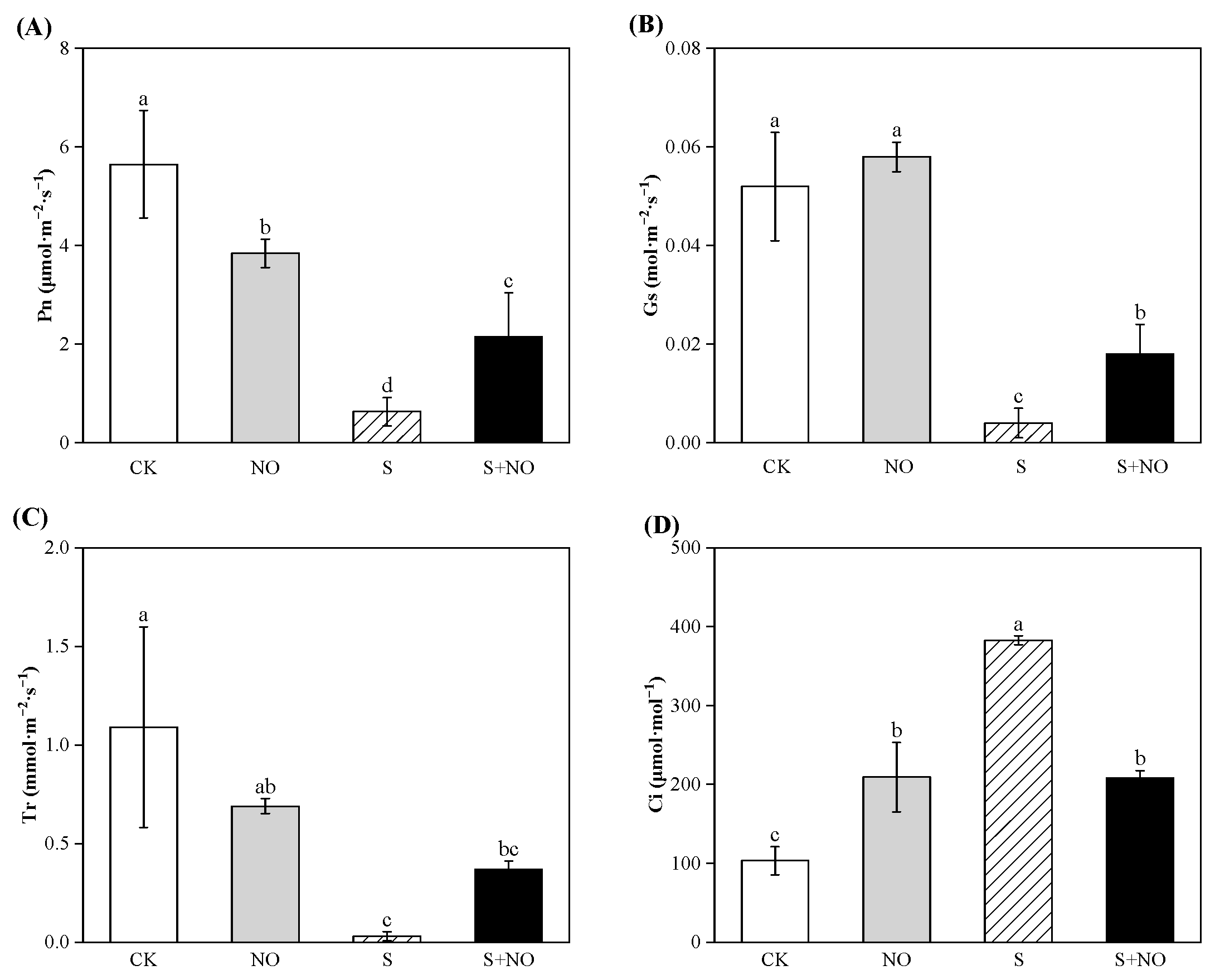
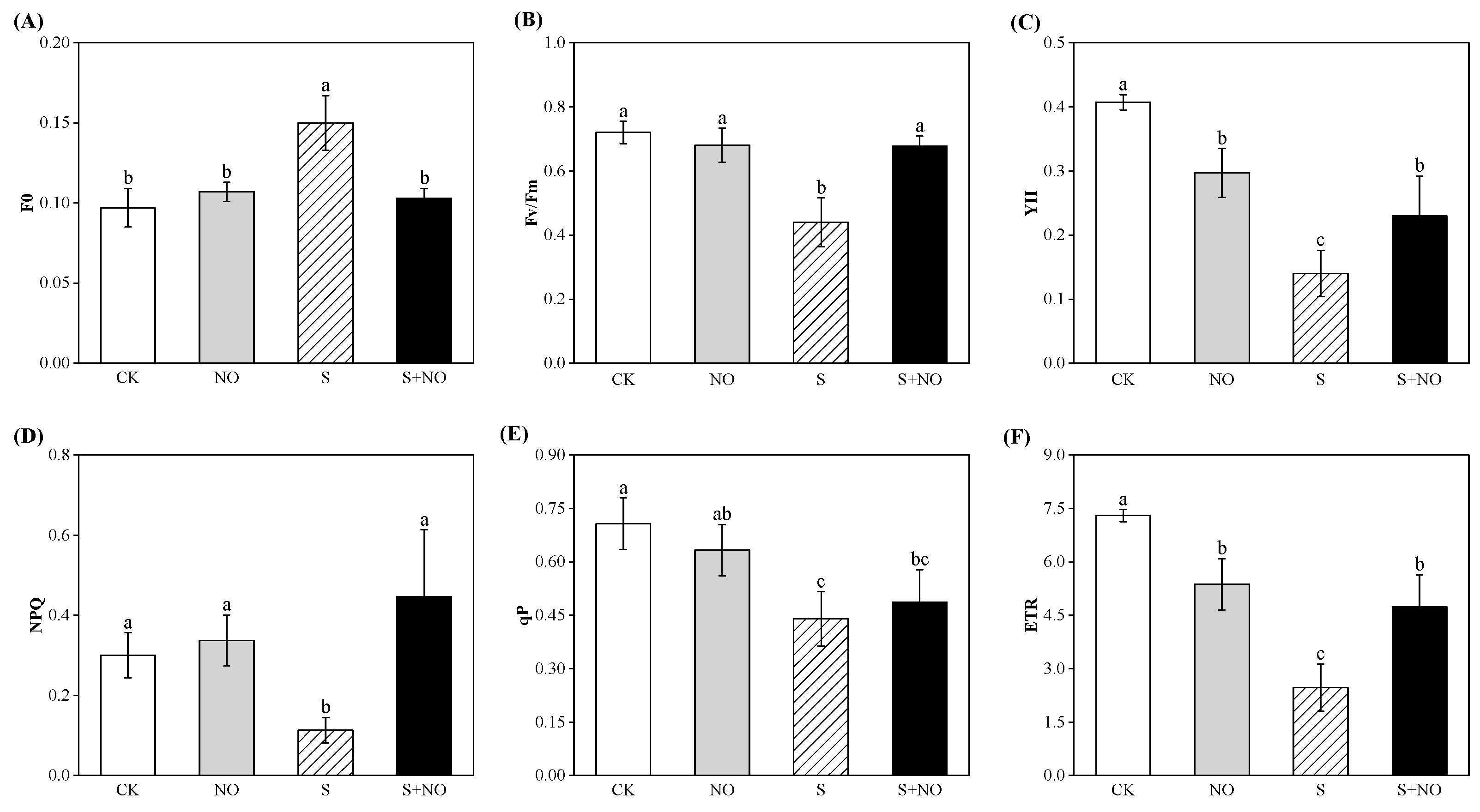

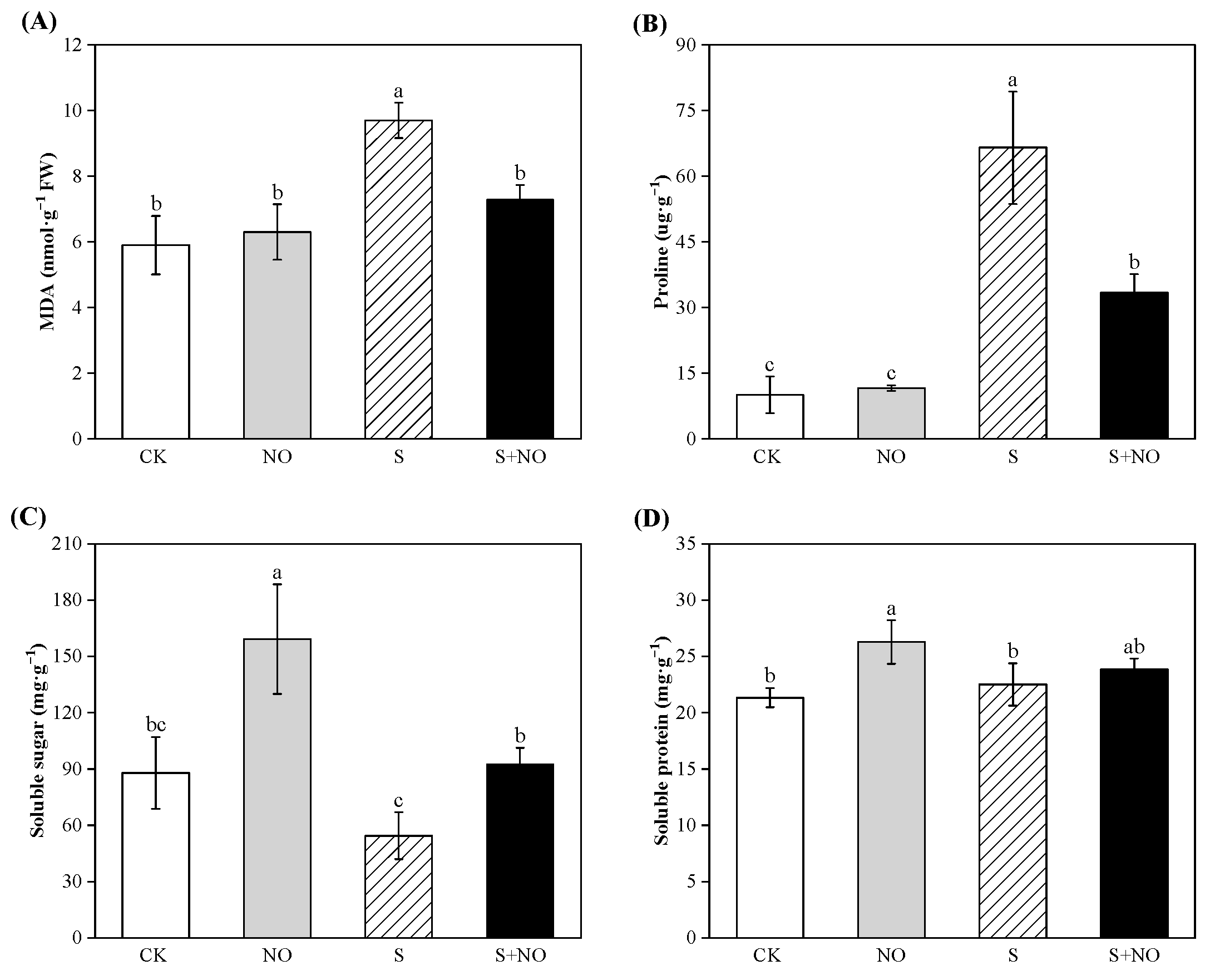


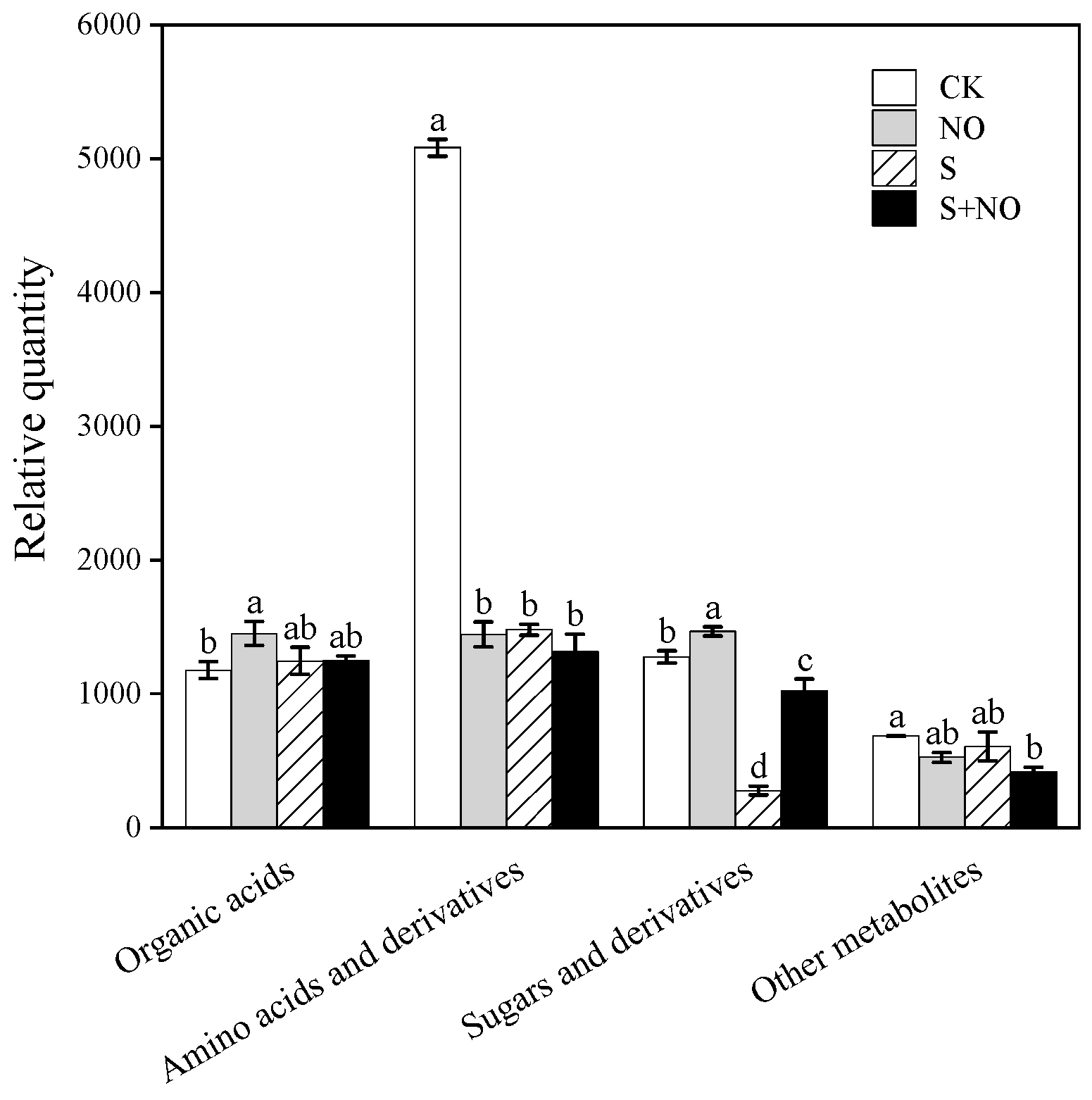
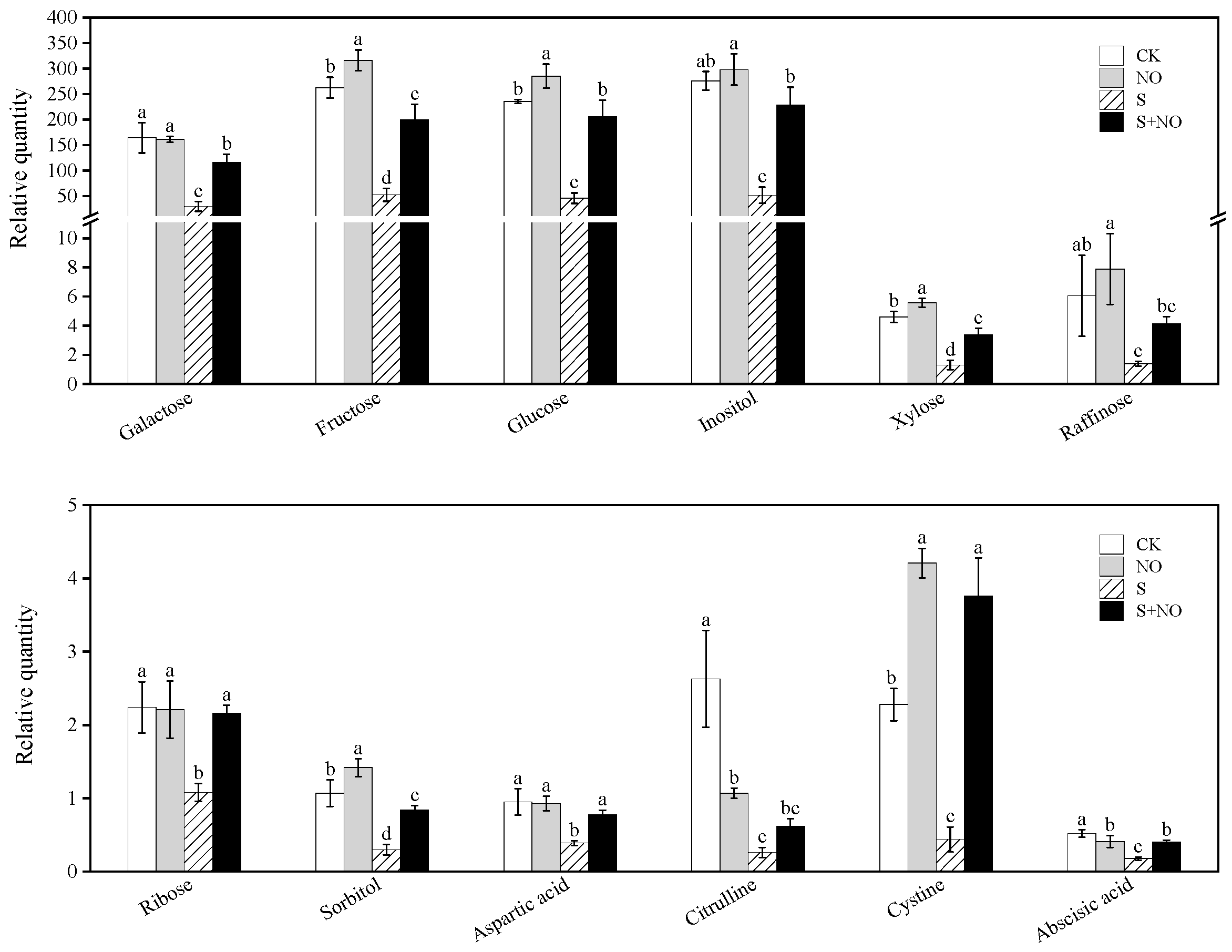
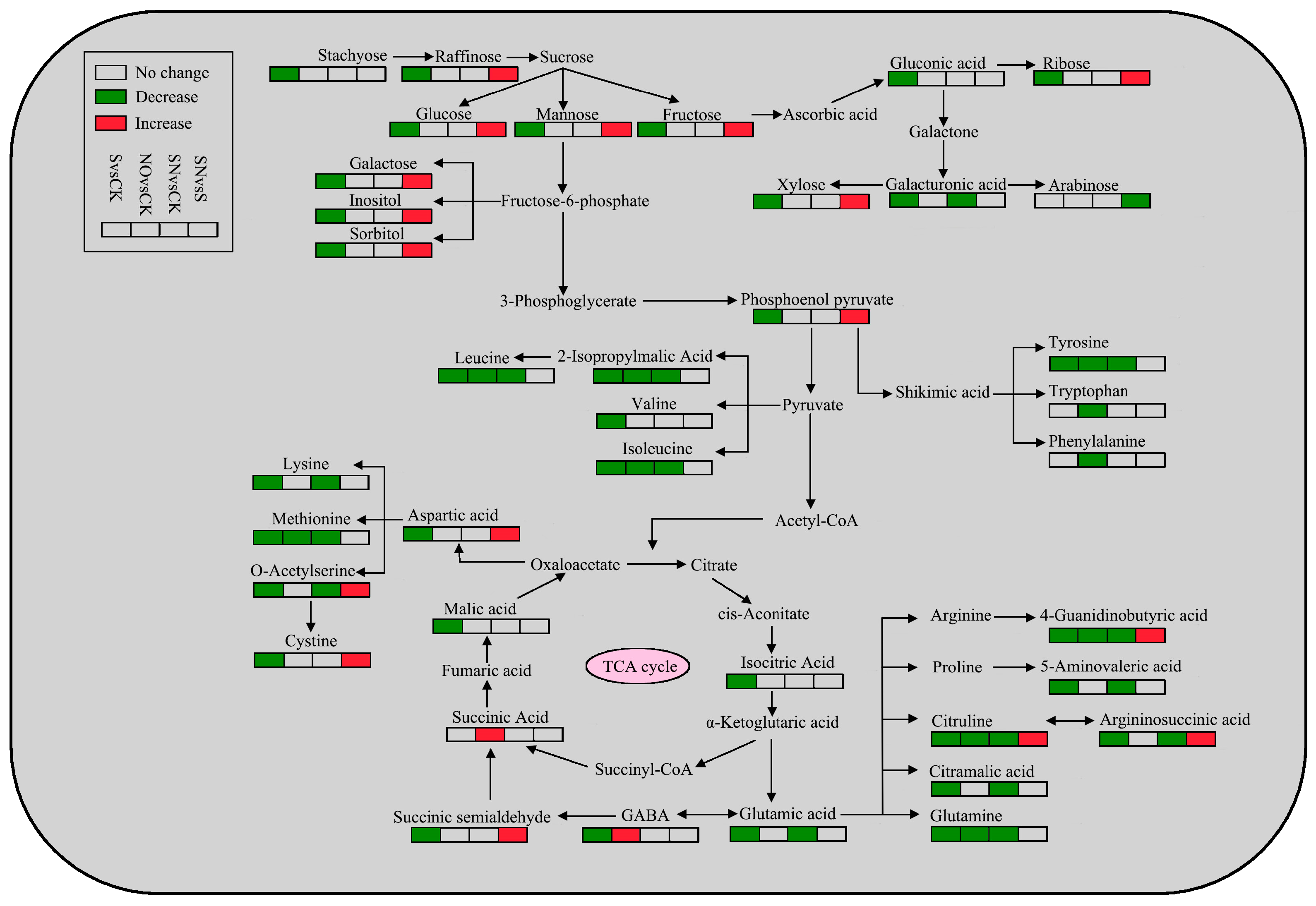
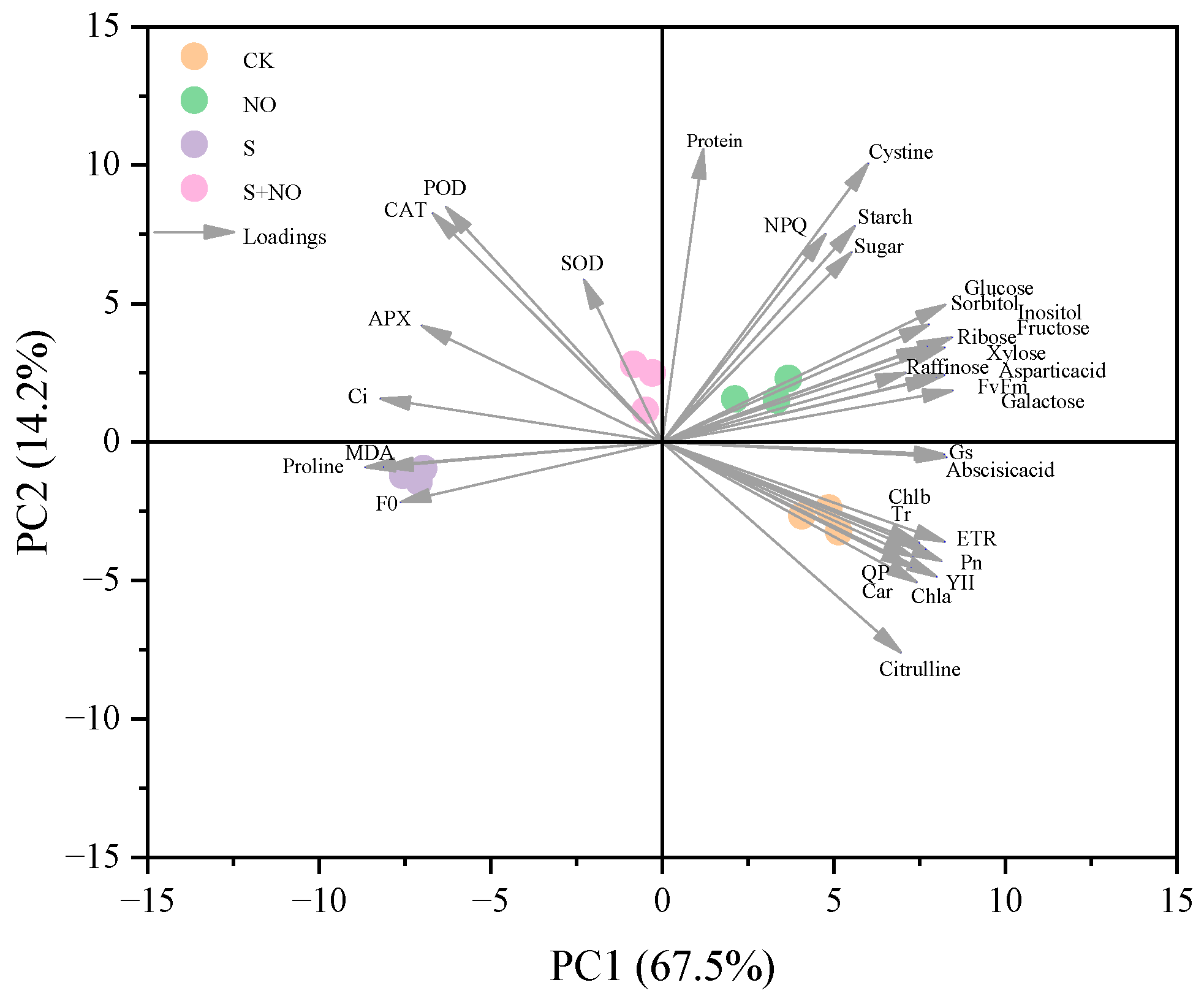
| Treatments | Stem Length (cm) | Root Length (cm) | Leaf Length (cm) | Leaf Width (cm) | Leaf Area (cm2) |
|---|---|---|---|---|---|
| CK | 7.17 ± 0.87 a | 20.43 ± 3.7 a | 15.17 ± 2.05 a | 21.8 ± 2.63 a | 201.76 ± 21.9 a |
| NO | 5.23 ± 0.87 b | 21.7 ± 3.33 a | 13.47 ± 0.15 a | 19 ± 0.2 b | 129.83 ± 9.27 b |
| S | 4.37 ± 0.15 b | 15.23 ± 0.87 a | 9.07 ± 0.9 b | 12.47 ± 0.76 c | 70.44 ± 8.66 c |
| S + NO | 5.4 ± 0.3 b | 19.83 ± 5.43 a | 12.97 ± 0.15 a | 17.6 ± 0.44 b | 125.65 ± 1.04 b |
| Sig | ** | ns | ** | *** | *** |
| F-value | 10.1 | 1.7 | 15.8 | 23.8 | 54.3 |
| CV (%) | 21.6 | 21.0 | 19.9 | 21.0 | 37.8 |
| Treatments | Shoot Biomass (g) | Root Biomass (g) | Total Dry Biomass (g) | Total Fresh Biomass (g) | Root/Shoot |
|---|---|---|---|---|---|
| CK | 5.73 ± 0.32 a | 1.73 ± 0.21 a | 7.46 ± 0.53 a | 29.58 ± 2.18 a | 0.3 ± 0.02 ab |
| NO | 5.25 ± 0.61 ab | 1.73 ± 0.1 a | 6.98 ± 0.56 a | 27.7 ± 2.93 a | 0.33 ± 0.05 a |
| S | 4.03 ± 0.22 c | 0.98 ± 0.13 b | 5.01 ± 0.16 c | 20.76 ± 0.85 b | 0.24 ± 0.05 b |
| S + NO | 4.69 ± 0.08 bc | 1.24 ± 0.09 b | 5.92 ± 0.17 b | 23.58 ± 1.35 b | 0.26 ± 0.01 ab |
| Sig | ** | *** | *** | ** | ns |
| F-value | 12.2 | 22.5 | 22.5 | 12.0 | 3.5 |
| CV (%) | 14.8 | 25.3 | 16.5 | 15.7 | 16.4 |
Disclaimer/Publisher’s Note: The statements, opinions and data contained in all publications are solely those of the individual author(s) and contributor(s) and not of MDPI and/or the editor(s). MDPI and/or the editor(s) disclaim responsibility for any injury to people or property resulting from any ideas, methods, instructions or products referred to in the content. |
© 2024 by the authors. Licensee MDPI, Basel, Switzerland. This article is an open access article distributed under the terms and conditions of the Creative Commons Attribution (CC BY) license (https://creativecommons.org/licenses/by/4.0/).
Share and Cite
Hu, X.; Zhang, M.; Liu, J.; Cheng, X.; Huang, X. Metabolomics and Physiological Changes Underlying Increased Tolerance to Salt Stress Induced by Applied Nitric Oxide in Fatsia japonica Seedlings. Forests 2024, 15, 159. https://doi.org/10.3390/f15010159
Hu X, Zhang M, Liu J, Cheng X, Huang X. Metabolomics and Physiological Changes Underlying Increased Tolerance to Salt Stress Induced by Applied Nitric Oxide in Fatsia japonica Seedlings. Forests. 2024; 15(1):159. https://doi.org/10.3390/f15010159
Chicago/Turabian StyleHu, Xing, Min Zhang, Jiao Liu, Xiaomao Cheng, and Xiaoxia Huang. 2024. "Metabolomics and Physiological Changes Underlying Increased Tolerance to Salt Stress Induced by Applied Nitric Oxide in Fatsia japonica Seedlings" Forests 15, no. 1: 159. https://doi.org/10.3390/f15010159





